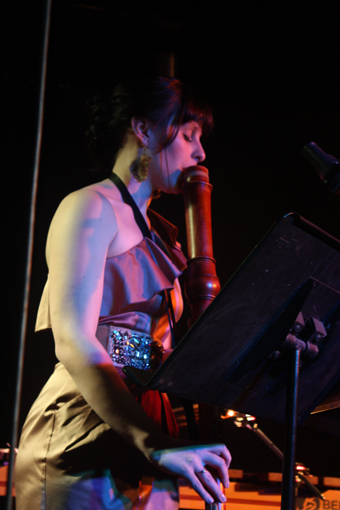 |
Alicia Crossley photo Erin Cardenzana |
Addicted to Bass, the performance I attended, was part of this ongoing project. Alicia Crossley had approached seven of Australia’s leading young composers during her Masters research into bass recorder performance, to compose “pioneering works that would launch the bass recorder into the twenty-first century, pushing extremes.”
Financing these commissions herself, Crossley was determined not only to develop the repertoire of her favourite instrument but to feed Sydney’s budding new-music scene. This endeavour ticked all the boxes of contemporary composition: obscure instrumentation, sexy performer and underground venue (Sound Lounge is a concrete bunker under Sydney University’s Seymour Centre). The ambitious compositions delivered by the beautifully bejewelled Crossley varied in listenability. Some compositions explored the crossovers and divides of timbral combinations, including Tristan Coelho’s As the Dust Settles. Others felt like they might have been better expressed through poetry or dance rather than the abstract world of sound. In some cases, such as Night Seller Tissue Season by Hayden Woolf, Canto-Fiato by Chris Williams or Calliphora by Mark Oliveiro, the concepts were easier to appreciate than their execution in composition and performance.
Calliphora is the Latin name for the common blowfly. Oliveiro’s work for bass recorder and electronics was designed to mimic the sounds that might be heard if a tiny microphone were placed under a fly’s wings. Making use of trills and overblown high notes, it would make the perfect soundtrack to an interactive aeronautical museum. At times echoes seemed to come through long tin piping, hinting at the digestive system of a mechanical cockroach. A motif of overblown harmonics had Aboriginal dreamtime overtones.
Woolf’s trio for soprano, piano and bass recorder entered the bleak world of illegal organ trade. Supposedly this was a metaphor for the recorder’s innocent, disjointed and vulnerable reputation. With lyrics that included: “thieves laugh, cash comes in...vascular vulture he is slicing our surgical frown...we are meat, just meat to you, milked of our meat...payment refused, organ abuse...” and a rollicking piano line, the treatment of this very serious issue played out musically as too tongue in cheek. “Defective subjects screech...” soprano Anna Fraser shrieked. As pure musical romp, it had good movement and contrasting sections but it could have been written for any instruments. The bass recorderness was not immediately apparent.
Doppelganger by Elias Constantopedos continued in the language of 20th century composers for recorder including Hans Ulrich Staeps and Chiel Meijering. However, rather than creating layered lines in ensemble writing, he let technology duplicate and modify solo sounds. All electronics were created live from the bass recorder input and shaped by sound engineer Ben Carey.
Impulse Stream, Alex Pozniac’s work for solo bass recorder was the stand out, seeming to come from a well-defined source, a self-etched canon including solo works Mercurial, Interventions, Crush and Flying Verticles. To communicate the value of the usually marginalised recorder, Pozniac revealed some of the technical skill required to play it well. Recognising the big recorder’s tone production as “fragile and malleable” Pozniac’s piece allowed Crossley to demonstrate her technical brilliance by withdrawing her instrument from the equation, at times having her sing and vocalise the tonguing she would otherwise direct into the recorder: T k t k t tktktktktktk. WoooooOOOooooo. The composition also captured allusions to childhood self-consciousness by having Crossley whistle and sing in a high-pitched, nervous way. Her little girl voice begged pardon for her technical virtuosity in a wonderful opposition. Pozniac not only explained the technical stream of recorder playing but the impulses of the recorder player’s self doubt.
Andrew Batt Rawden introduced his piece E, for bass recorder and electronics, as a battle. His title is derived from the abbreviated name for Ecstasy, a drug Batt Rawden admits he has never tried. He imagines the drug helps to “transcend consciousness and exit corporeality into a darker side of the mind” and that while the drug is said to produce a friendly haze, there is “more to love than the fluffy bits.” But what of the performance? Crossley looked great in chunky headphones but her recorder was so heavily miked that sheet-music page turns turned out to be major sound events in the battle.
Addicted to Bass was built on a solid base of musical integrity if sometimes competing with an aura of glamour. The project has been a success in the sense that repertoire for bass recorder has been expanded. By producing a commercial recording a space of reverence has been carved out around these new compositions: a sort of self validating gesture which is absolutely valuable because who is better equipped to judge the merit of this innovation than musical peers? These young composers have collectively asserted that these works are worth circulating.
Alicia Crossley and Chronology Arts: Addicted to Bass, performers Alicia Crossley, Vatche Jambazian, Victoria Jacono, Joshua Hill, Anna Fraser and Ben Carey, Seymour Centre, Sydney, Aug 25
RealTime issue #105 Oct-Nov 2011 pg. 41
© Felicity Clark; for permission to reproduce apply to [email protected]








 back
back